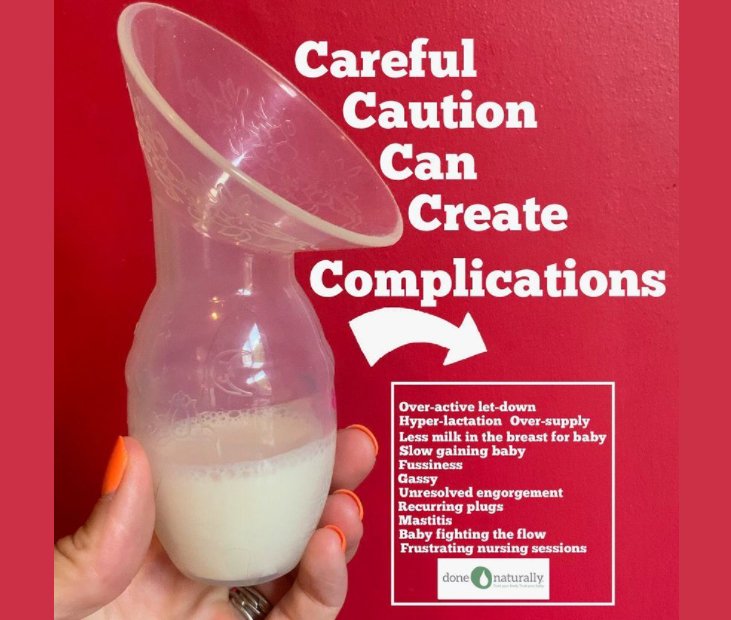Image by Summer Friedmann, IBCLC (Done Naturally) (Source)
Many lactation consultants are concerned about the wide-spread use of silicone breast pumps, such as the Haakaa. They see issues like:
- oversupply
- vasospasm/ pain (because it's constant suction is left on too long)
- slow weight gain (because the Haakaa is taking the milk the baby needs)
- clogged ducts/ mastitis (because Haakaa leaves the most fatty milk inside the breast)
Does Haakaa increase milk supply and potentially cause oversupply?
Unfortunately, there is no research on the side effects of using the Haakaa. Haakaa USA acknowledges that "Haakaa’s suction does extract milk which may increase your supply" (Source). However, there is some debate as to whether the Haakaa is considered a 'pump' or just a 'milk catcher' (since it's passive). It is definitely NOT something that lactation consultants would use in case of genuine low supply. But could it dysregulate a healthy supply and cause oversupply?
Although there is no scientific evidence that the Haakaa can cause oversupply, there is anecdotal evidence. Also, Google Trends shows that searches related to "haakaa oversupply" have increased dramatically in recent years:

Haakaa looks like a breast pump and potentially acts like one.
Looking at the design of the Haakaa, it closely resembles a breast pump: it has a flange, a narrow opening for the nipple and a bottle-shaped receptacle for the milk.
The narrow opening means that any amount of suction that is generated is focused on the nipple area and hence, towards drawing out breast milk.
The size of the bottle consciously or unconsciously sets an expectation as to how much milk it is supposed to hold. Barely filling up the bottom of a bottle (no matter what pump is used) does not make anyone feel good. Especially in the face of all those social media posts showing bottles and entire freezers overflowing with pumped milk.

Image: Haakaa-style silicone breast pump compared to conventional breast pump.
Can you see the potential vicious cycle? How the Haakaa might encourage excessive milk removal, to the point where baby is getting less and/or supply gets dysregulated, while being hard on the sensitive nipple/ areola area? Even without any visible nipple trauma, it's possible that excessive/ prolonged suction pulls interstitial fluids into the areola - making it less flexible and harder to gain a good latch.
While Haakaa, the company, can be blamed for many things (such as violating the WHO code or disrespectfully appropriating indigenous language and symbolism in their branding), they didn't come up with this problematic design. I believe they simply looked at a conventional breast pump and simplified it. But it still looks like a breast pump. Hence, it may not be a surprise if it inherited some of the known risks associated with breast pumps: nipple pain/ nipple injury, perceived inadequate supply etc. (Source)
From saving leaking milk to hand expression.
One of the most attractive features of the haakaa is it's simplicity: one single silicone piece, no assembly required. And taking advantage of the letdown for collecting breast milk also makes sense! It's much easier to get milk when the body is ready to release it naturally. Collecting some milk while breastfeeding costs practically no extra time (compared to conventional pumping, which is done in addition to nursing and can be time consuming).
However, as discussed above, there are still potential risks and undesirable side effects and I think we can and should do better!
kindestCup is a radical departure from conventional breast pumps. It's flange-less organic shape looks nothing like a breast pump.

Image: Haakaa-style silicone breast pump compared to kindestCup
With it's large opening it can suction to the breast and collect leaking milk but the suction is distributed over a much wider area of breast tissue, which not only feels gentle but also makes for a secure hold. The amount of suction that the nipple 'sees' it much reduced, compared to the Haakaa, so little or no extra milk is drawn out (beyond what would leak naturally).
kindestCup's reservoir is tapered and doesn't have a volume scale. It makes any amount of milk look perfect.
While saving leaking milk is a nice feature to keep your clothes dry when you're breastfeeding, it is not something I would rely on for milk collection. First, not everybody leaks and even people who do leak, often don't leak for the entire duration of the breastfeeding journey (often, the sphincter muscles around the ducts get stronger and better coordinated at some point and the leaking stops). Second, catching leaking milk works best when you're with baby (i.e. while nursing). But often, effective milk removal is most critical is when you're away from baby and a milk catcher (even with some suction) just won't cut it. Third, drip milk, another word for leaking milk, is notoriously low fat. Many milk banks do not accept drip milk as donations. If you collect drip milk, make sure to add some hand expressed milk to boost the fat content before putting it away or feeding it to baby. This also helps to prevent clogs inside the ducts that are caused by fat that isn't removed effectively.
Hand expression is a great way to manage milk supply in almost any situation! In fact, hand expression is was what inspired the novel design of kindestCup. kindestCup has a perfect ergonomic shape to catch hand expressed breast milk in a comfortable upright or laid back position.
And as a bonus, kindestCup can also be used for cup feeding :)
Conclusion
To summarize, if you are worried that Haakaa will cause oversupply your concerns are valid and backed by anecdotal evidence from lactation professionals. Consult a lactation consultant on how to use the Haakaa (or any other breast pump) safely and know that there are potential alternatives, such as kindestCup.
Written by Melanie Scholz, PhD
Creator of kindestCup.com





